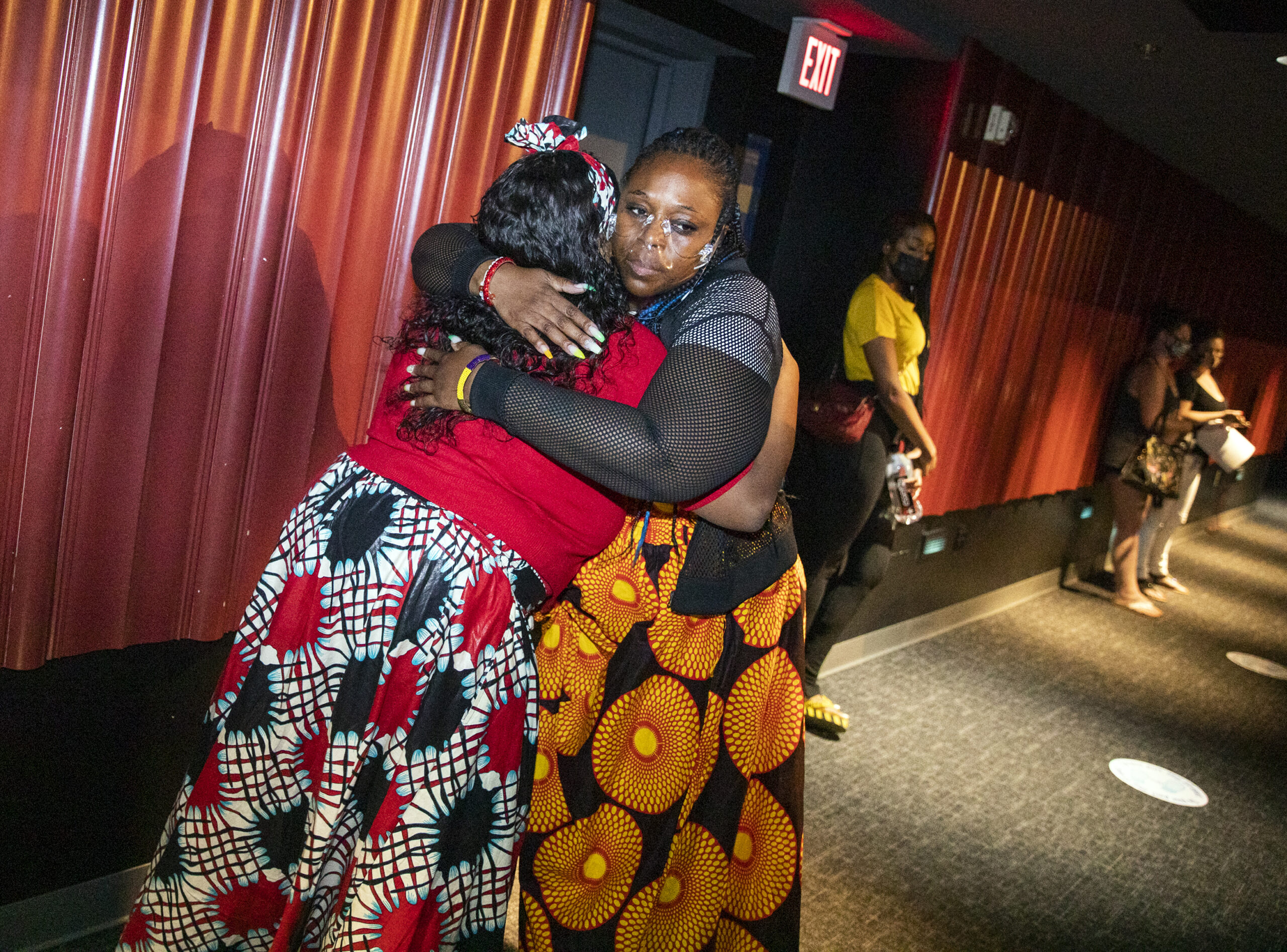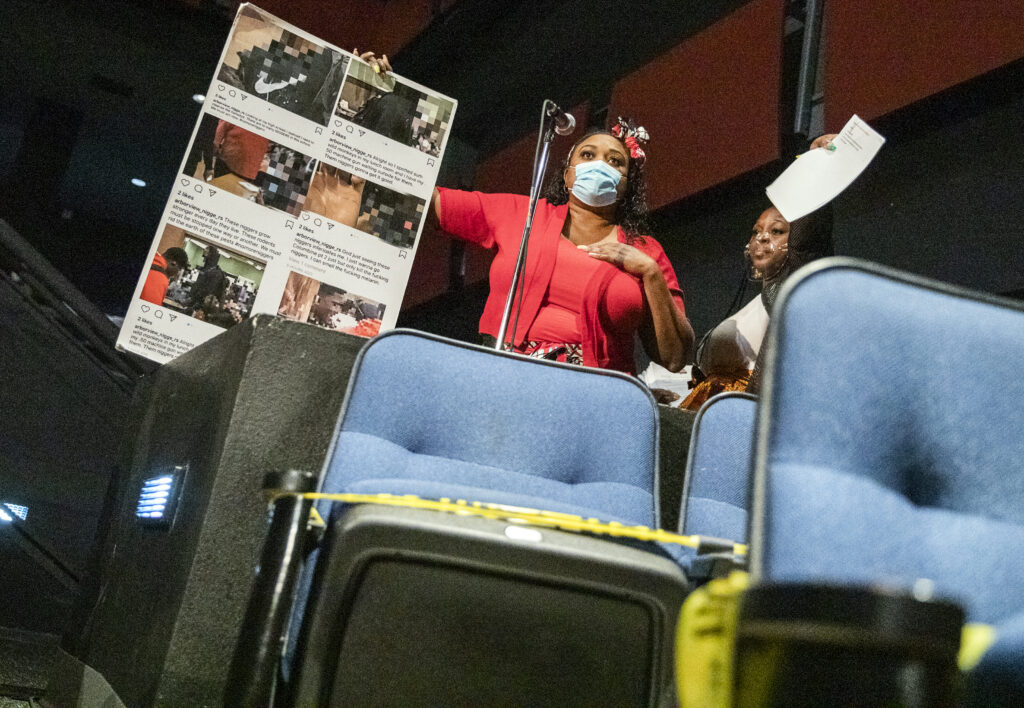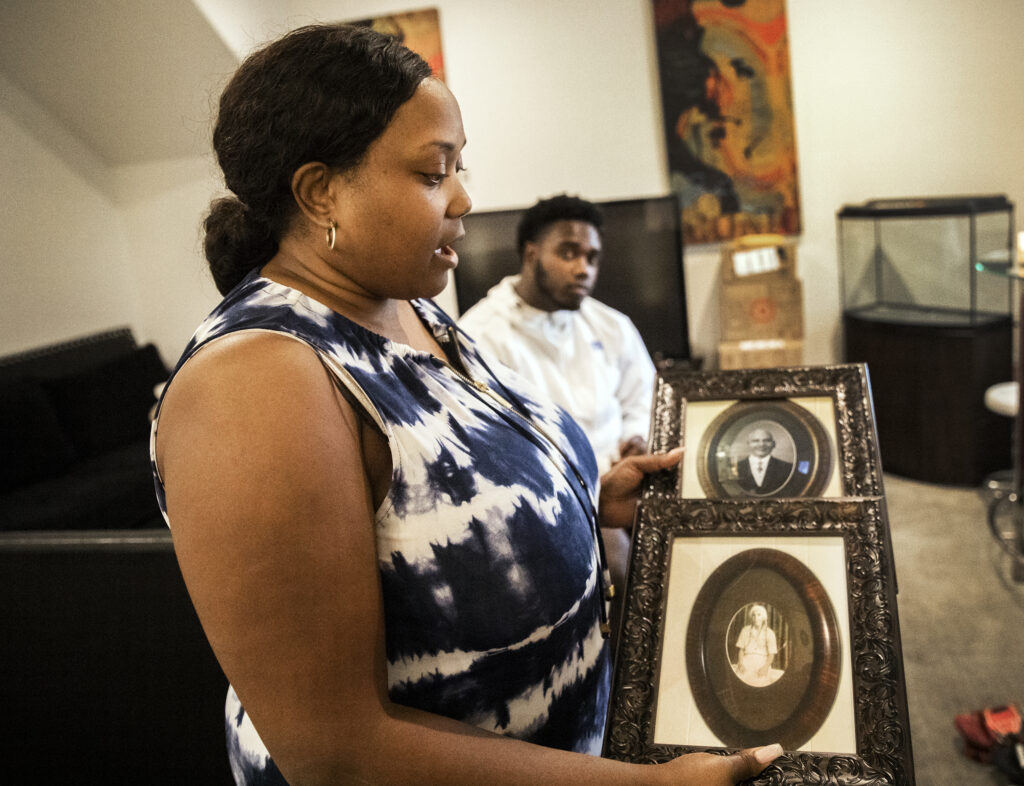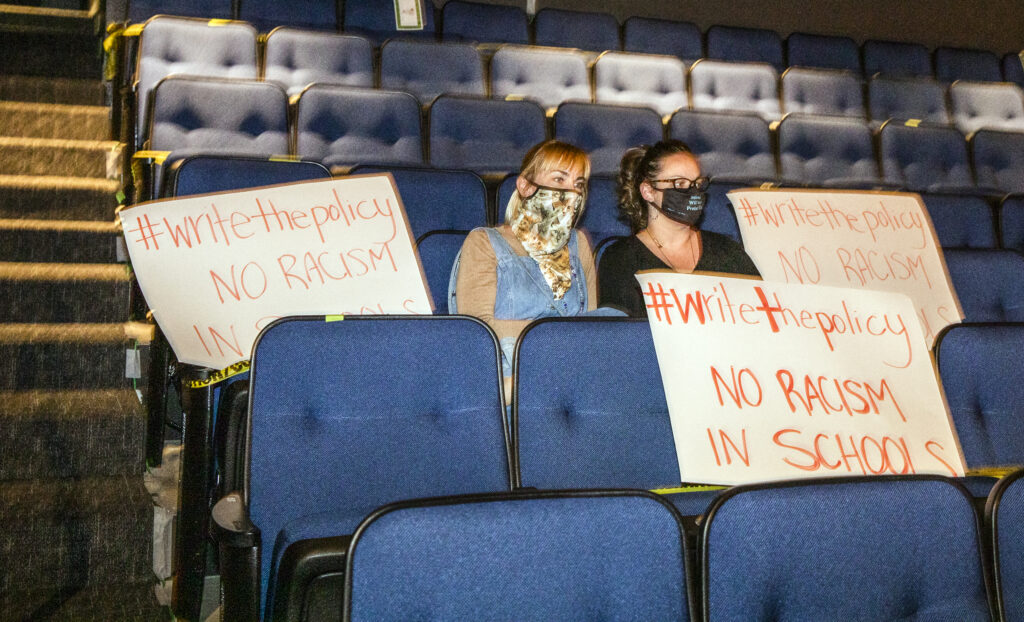Racist threats against their sons fueled two mothers’ push for an anti-racism policy in Clark County schools

Before the emcee finished his plea for civil and respectful discourse, a line had formed along a wall inside a Clark County library meeting room.
It was early afternoon on a Saturday — two weeks into the new academic year — and several dozen people had gathered to discuss an anti-racism policy, now in the drafting stage, that will be under consideration by Clark County school officials. Now, it was their turn to speak.
A Clark County School District graduate shared how she spent years straightening her hair after a classmate criticized her cornrows, saying she looked “too Black.”
A former teacher and school administrator explained how she was retaliated against for refusing to practice exclusionary discipline policies that too often affected students of color.
A Las Vegas High School student, who also serves as student body president, expressed dismay that her academic success has invited what she sees as disproportionate praise because of her skin color and the fact that her father is an immigrant.
Personal stories like these are giving Jshauntae Marshall and Akiko Cooks the resolve to keep showing up to school board meetings, writing letters, making phone calls and organizing town halls like this one. As the mothers of current and former students — two of whom were the victims of a racist threat that made headlines two years ago — they have made it their mission to make sure racism isn’t tolerated in Clark County schools.
The name of the organization they founded underscores their mission: No Racism In Schools #1865, or 1865 for short, a nod to the year the 13th Amendment was ratified, abolishing slavery.
“I was very proud of those who did speak out,” Cooks said about the town hall. “That makes 1865 say, ‘How do we support you more in this? Where do you need us to show up?’”
For more than two years, these mothers have been pushing for a policy that would take a proactive stance against racism and spell out how race-based incidents should be handled when they do arise. Supporters say it’s no longer enough to not be racist; individuals, institutions and society need to identify and challenge the values and systems that perpetuate racism, hence the action-oriented term “anti-racism.”
But the process for creating an anti-racism policy has not been swift, nor has it been without the vitriol — and misguided mentions of critical race theory — permeating similar discussions nationwide. A June school board meeting devolved into chaos after an argument among attendees broke out during a public comment period. Even the town hall was briefly interrupted by a pair of detractors.
It’s all evidence, Cooks and Marshall say, of why the school district desperately needs such a policy. In March, No Racism in Schools #1865 sent a follow-up letter to Clark County Superintendent Jesus Jara demanding the creation and implementation of an anti-racism policy districtwide. It built on what they had requested shortly after their sons were the victims of a racist threat in March 2019. The letter included 17 “non-negotiables,” ranging from community representation and input during the policy’s creation to establishing disciplinary standards for students and staff who violate the forthcoming policy. It came a week after the Clark County School Board of Trustees agreed to start developing a policy.
The policy initiative speaks to the current moment in the nation’s racial reckoning. Police killings of George Floyd, Breonna Taylor, Elijah McClain and others unleashed a wave of protests and calls for systemic change amid a pandemic that has disproportionately harmed people of color. Some of the focus has naturally shifted toward public schools, the bedrock of most communities, where the nation’s youngest generations come to learn.
In Nevada, the foundation for school anti-racism policies has already been set in state law. Assembly Bill 371, which passed through the Legislature and was signed by Gov. Steve Sisolak this year, requires racial incidents to be handled in a manner consistent with an existing anti-bullying law.
An anti-racism policy won’t undo the pain Marshall and Cooks’ families endured when an ugly Instagram post surfaced two years ago. But the mothers say it could deter similar racially motivated incidents or, at the very least, provide schools a roadmap for addressing them.

On the evening of March 18, 2019, Cooks received a chilling text message. A cousin had stumbled upon racist Instagram posts targeting nine Black students at Arbor View High School. Her son, Corey Landrum, was one of them.
Photos of the nine students, snapped without their knowledge, accompanied text rife with racial slurs and threats of a “Columbine pt 2” shooting. Cooks immediately called school district police, only to be told it was out of their jurisdiction because it happened online. So she shared the post on her own Facebook and Instagram channels as a warning to other parents.
Overnight, the post and related warnings had circulated social media. Marshall came across the post at 6 a.m. the next day and saw her son, Zamier Marshall, in a photo. Before even fully processing what she had seen, Marshall grabbed her phone and began calling and texting other parents. She frantically relayed a singular message:
“Don’t send your kids to school today.”
Cooks and Marshall say a lack of information from the school district heightened an already-frightening, emotional situation. An investigation ultimately led to the arrest of two students, who later accepted a plea deal. But the mothers, bonded by a painful experience, knew their work wasn’t done.
“For me, my life will never be the same from that,” Cooks said. “It’s changed everything.”
The mothers knew racism existed within the walls of Clark County schools, just as it does essentially everywhere across the country, from retail stores and restaurants to doctor’s offices and hospital waiting rooms. A recent Gallup poll found that a majority of Americans — 64 percent — believe racism against Black people is widespread in the United States, and that perception is even higher among Black (84 percent) and Hispanic (72 percent) respondents.
Racial disparities in student discipline, police violence and health care, among other examples, underscore the nation’s long-standing problem.
Cooks and Marshall had seen Confederate flag imagery adorning student vehicles in the Arbor View High School parking lot. They tried not to dwell on it.
Marshall said she taught her son to keep his distance. It’s a conversation that many Black parents across the United States have with their children, especially as their sons grow into young men and enter a society that judges them based on the color of their skin.
“I don’t teach my children to be angry at people for their personal perspectives,” she said. “If they hate Black people, then let them hate us. Just don’t put your hands on us.”
The racist Instagram posts, however, brought their daily worries to a head. These were their sons, their babies, targeted in a threatened shooting. A lethargic response by both the school district and local police, they say, proved something more needed to be done.
That’s how No Racism In Schools #1865 came to be. The organization’s website describes itself as a “campaign focused on closing the gaps in policies, laws, and protocols that govern race related matters in schools.”
The vehicle for doing so, they believe, is an anti-racism policy. Cooks and Marshall envision the policy holding the district accountable for appropriately handling race-based incidents, tracking their occurences and weaving the concept of anti-racism into the curriculum — similar to how policies adopted by other school systems look and work. They’ve shared some with district officials.
The policy would align with AB371, which builds off the anti-bullying law and applies to all 17 public school districts and charter schools. During the town hall, the bill’s sponsor, Assemblywoman Brittney Miller, who’s a teacher, said she often fields this question: Isn’t racism considered bullying?
The answer, she said, lies in the definition of bullying. Whereas bullying involves targeted, recurring incidents, a single racist incident would enact the protocols of AB371. Miller gave this example to explain the importance of the distinction: If a student writes “you’re a jerk” on a bathroom wall, the message may elicit a few glances and giggles. But if the writing on the wall includes a racial slur, it affects everyone who reads it.
“So it doesn’t have to be targeted; it doesn’t have to be repetitive,” Miller said. “The reason why this is key in the definition is because that’s why many students — their reports of racism were going unaddressed because it didn’t comply with that same (bullying) standard.”
Cooks said the addition of the anti-racism policy at the district level would add a “second layer of protection” by defining terms and going beyond the data-tracking components of AB371. For instance, she said, the policy should “decolonize the curriculum” by ensuring that students learn about the societal contributions made by people of color, not just the history of slavery. The organization’s vision dovetails with another new state law, AB261, that makes sure more diverse perspectives are included in K-12 academic content.
The policy push, however, has come under fire from critics who say it’s masquerading as an attempt to teach critical race theory, an academic framework that examines how racial inequality is woven into the U.S. legal system and other institutions. Critical race theory has emerged as a commonly misused catch-all term by people who oppose any policies that address systemic racism. It has also been adopted as a campaign talking point by conservative candidates in recent months.
Clark County Superintendent Jesus Jara and several trustees have declared that critical race theory, which became a flashpoint during fiery school board meetings across the nation this summer, will not be part of district discussions regarding the anti-racism policy.
As far as Cooks and Marshall are concerned, the anti-racism policy must come first.
“I think it’s a necessity, but until there is an anti-racism policy that is actually enforced, I don’t know that our educators, generally speaking, are skilled enough to go there,” Marshall said, referring to critical race theory. “They barely can have a conversation about body shaming.”
While the anti-racism policy won’t delve into critical race theory, Cooks and Marshall say candid conversations about racism and implicit biases — beliefs about or attitudes toward others that people hold without consciously realizing it — need to occur. They also say it’s not an “anti-white policy,” as some opponents have called it; it’s simply anti-racist, which is a mindset they would like to see everyone adopt.
“You can’t do an anti-racism policy without a lens on race,” Cooks said. “There has to be a discussion.”


The Clark County School District wouldn’t be forging new ground by creating an anti-racism policy. School districts in Cincinnati, Ohio; Charlottesville, Virginia; and Niskayuna, New York, are among those that have already adopted similar policies.
The Board of Education for Cincinnati Public Schools took that step last December. The southwest Ohio district predominantly serves communities of color, with 62 percent of students identifying as Black and 8 percent identifying as Hispanic. The racial unrest during the summer of 2020 fueled a request from Board Member Mike Moroski and, later, students for a policy that would go beyond the district’s existing one regarding equity.
The Cincinnati district’s anti-racism policy defines pertinent terms such as racism, anti-racism, individual racism, systemic racism and racist or race-based misconduct. The policy, for instance, says systemic racism “encompasses the history and current reality of institutional racism across all institutions and society. It refers to the history, culture, ideology, and interactions of institutions and policies that perpetuate a system of inequity that is detrimental to communities of color.”
The policy also includes a 363-word section describing its purpose, with the first line stating that it is “to create processes that identify any form of racism, work to counter its effects and work to eliminate racist practices and policies from the District in conjunction with related Board policies.”
The policy goes on to list a variety of directives related to communication, leadership and administration, curriculum and instruction, professional development, hiring and discipline.
“Unless you’re calling it out, you’re not going to change it,” Moroski said.
In Cincinnati, an anti-racism working group — made up of students, staff, parents and community organizations — developed the policy based on public feedback. The African American Chamber of Commerce, Cincinnati Children’s Hospital Medical Center, The Urban League and YMCA were among the organizations involved.
The school district’s assistant general counsel, Stephanie Scott, said the working group came together last August and, by mid-December, the policy had been approved by the board.
“We didn’t want to have a knee-jerk reaction,” she said. “... We knew it was going to be a longstanding policy that we really wanted to give some thought and be really intentional so, in doing that, we wanted to make sure that we included ... all of our key stakeholders.”
The Clark County School District has taken a similar approach, creating both an internal and external task force. Additionally, it has brought aboard four people deemed professional experts — Donna Mendoza Mitchell, Maree Sneed, Micah Ali and Shawn Joseph — who have backgrounds in civil rights law, education policy and school leadership. They will be listening to task force discussions and helping draft the written policy, said Mike Barton, the district’s chief college, career, equity and school choice officer.
Cooks and Marshall are among the 38 members of the external task force, though they’re not pleased with the selection process. They have raised concerns about the lack of representation from the city’s Historic Westside, which is a historically Black neighborhood; the unwieldy size of the group; and the inclusion of a few members whom they don’t consider allies.
“Why do we have to be put in a space with someone we know doesn’t really support this?” Cooks said.
No Racism In Schools #1865 has recommended that task force members participate in implicit bias training sessions. Barton, meanwhile, said the district is “definitely having conversations with the community” about the concerns regarding representation from the city’s historically Black neighborhood.

Still, the process has irked School Board President Linda Cavazos, who described it as “moving at a snail’s pace.” Trustee Katie Williams, on the other hand, has advocated against expedited timelines, pointing to the district’s gender-diverse policy, which took 18 months to craft and adopt.
“I want to get it done properly and accurately,” Williams said during the Aug. 26 board meeting.
(The founders of No Racism In Schools #1865 have not invited Williams — known for her incendiary tweets, one of which recently included a Qanon hashtag — to any of their events.)
A development timeline shared with trustees in August sets January as the target for the final adoption of an anti-racism policy, with a first draft coming together in October.
As the policy formation process plays out, those involved in the local education community are keeping a close eye on it.
Former Clark County School Board Trustee Linda Young was the only Black member when her term ended last year. Now, the school board has no Black trustees. Young routinely advocated for dismantling racial inequities during her tenure on the school board, and said she supports the creation of an anti-racism policy. She said it could encourage more candid dialogue about race — a topic sometimes considered taboo, especially in classroom settings.
Too often, she said, people are afraid of confronting issues they don’t feel equipped to discuss.
“When you’re talking about things you don’t know, you tend to avoid because, number one, you’re uncomfortable and, number two, you don’t know and you don’t want to let people know you don’t know,” said Young, who suggested that judgment be replaced with this mindset: “It’s OK that you don’t know. It is OK that sometimes I don’t know.”
Andrew O’Reilly, interim vice principal at Chaparral High School, attended the town hall organized by No Racism In Schools #1865 and Mi Familia Vota. He wanted to listen.
“I wanted to hear what their experience was,” he said, referring to community members who spoke during the town hall. “My job as an educator is for me to be a learner also.”
O’Reilly said he supports the creation of an anti-racism policy and believes it’s necessary. Students want to talk about these issues, he said, and they want to be part of a solution.
And, from an educator standpoint, he wants to see more training about how classroom and school leaders can improve the culture and climate.
“We sometimes have a tendency to think if we don’t see a problem overtly, that the problem doesn’t exist,” he said. “It comes back on us to really know what areas need to be addressed to keep everybody safe and included in society.”
Students may not be watching every twist and turn of the policy development process, but the topic itself isn’t far from mind. Alexa Hernandez-Valenzuela is a junior at Global Community High School, which serves students who are newcomers to the United States. Speaking in her native Spanish, Hernandez-Valenzuela said she would welcome a policy that aims to prevent racism.
It was one of her bigger fears when she moved to Las Vegas from Mexico roughly three months ago. Her parents had lost their jobs during the pandemic and sent her here to live with an aunt so she could finish her education. Hernandez-Valenzuela worried the language barrier might make her a target of racism, in school or elsewhere. She hasn’t experienced that at Global High School but said a policy could help prevent it moving forward.
People who give up their whole lives to move here, she said, deserve an opportunity free from racism.


After the racist Instagram threats at Arbor View High School, Jshauntae Marshall’s son, Zamier, transferred to Liberty High School in the southern Las Vegas Valley. He graduated in June. Now, he’s attending Concordia University Wisconsin, where he received a football and academic scholarship.
A few weeks after graduation, he reflected on how the incident had changed his outlook, especially after watching the pandemic and racial unrest unfold over the past year and half.
“Honesty, it just showed me that (there’s) a lot of hate in the world for no reason,” he said, adding that it really opened his eyes. “I’m 18 now. I’m grown and I look older than my age and (there have) been many experiences I’ve had, like, hand-to-hand with racial profiling.”
It’s a constant fear for his mother. That’s why she forbade him from wearing dreadlocks or being out at night when racial tensions were particularly high last summer following the police killing of George Floyd. She also steered him away from attending college in the South, worried he might encounter even more potent forms of racism there.
Marshall said her rules have created some friction between the two, but she hasn’t budged.
“I’ve not ever taught my children racism. I’ve taught them about it — and have drilled into his head that, as a Black man, he just can’t do what other people do,” she said. “He just can’t. And I don’t care how free they say he is, he will never have the freedom of other men his age.”
Cooks’ son, meanwhile, chose to remain at Arbor View High School. Her daughter, Chasity Landrum, is now a junior there, too. They’re both members of the school’s Black Student Union.
Corey Landrum, who’s finishing up final credits to graduate, tries not to fixate on the past. “What’s done is done,” he said.
Her brother’s experience didn’t dissuade Chasity from attending Arbor View High School. She sensed change could happen.
“I feel like there could be a difference,” she said. “So I guess I really do stay because I’m like, ‘It doesn’t have to be like this. You’re not going to run me away from my school.’ This is my area code. This is where I live.”
The reality is, the racist threats could have occurred at any school. Since launching No Racism In Schools #1865, Cooks and Marshall say they have received regular reports of racially motivated incidents at schools across the valley. The Arbor View incident, though, catalyzed efforts to rebuild the northwest valley school’s climate. The principal, Kevin McPartlin, calls it a cultural turnaround.
Cooks and Marshall have been heavily involved, he said, in helping with training sessions for staff that address how to discuss and handle race-related issues when they arise. The other part is extending that to students in an effective manner, McPartlin said, noting that it’s not a “quick fix” but instead needs to be thoughtful and ongoing.
“We’re a large high school — 3,200 kids — and you can’t just have an assembly about this and think it’s going to fix it,” he said. “We need to get down in smaller groups, and it needs to be conversation.”
The broader push for an anti-racism policy districtwide has at least started dialogue. But the founders of No Racism In Schools #1865 don’t want to see it end there. Cooks envisions youth empowerment as the next phase of the work.
The more students, parents and educators talk about it, she said, the more likely it is that the policy won’t just become papers stored on a shelf.
“It’s more than just creating a policy,” Cooks said. “It’s creating the right policy, implementing the policy, training on the policy, educating the community about the policy and enforcing the policy — and then accountability follow-up. We’re years away from that full process.”
Cooks and Marshall say they’re in it for the long haul. Progress will be measured by the experiences of the younger students aging through the school system.
Marshall’s second-grade son, Aiden, is among them.
